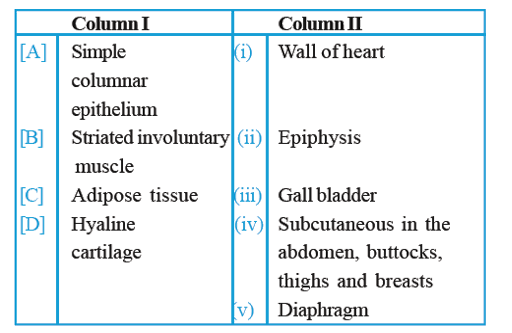Match column I with column II and select the correct option from the codes given below.
Column IColumn IIA.Planaria(i)Binary fissionB.Fungi(ii)Asexual sporesC.Yeast(iii)BuddingD.Amoeba(iv)True regeneration(v)Fragmentation
A-(i), B-(ii), C-(iii), D-(iv)
A-(iv), B-(ii), (v), C-(iii), D-(i)
A-(ii), B-(v), C-(i), D-(iv)
A-(v), B-(ii), (i), C-(iii), D-(iv)
The correct Answer is:B
To solve the matching question between Column I and Column II, we will analyze each organism and identify its corresponding mode of asexual reproduction.
1. Identify the Organisms and Their Characteristics:
- Planaria: A flatworm known for its ability to regenerate lost body parts.
- Fungi: A group of organisms that reproduce via spores.
- Yeast: A type of fungus that reproduces asexually through budding.
- Amoeba: A unicellular organism that reproduces by binary fission.
2. Match Each Organism with the Correct Mode of Asexual Reproduction:
- Planaria:
- Can regenerate and also reproduce through fragmentation. However, true regeneration is a more specific characteristic of Planaria.
- Match: (A) Planaria → (iv) True regeneration.
- Fungi:
- Reproduces primarily through asexual spores.
- Match: (B) Fungi → (ii) Asexual spores.
- Yeast:
- Reproduces by budding, where a small part of the parent organism detaches and grows into a new individual.
- Match: (C) Yeast → (iii) Budding.
- Amoeba:
- Reproduces by binary fission, where the organism divides into two identical daughter cells.
- Match: (D) Amoeba → (i) Binary fission.
3. Final Matching:
- A → iv (Planaria → True regeneration)
- B → ii (Fungi → Asexual spores)
- C → iii (Yeast → Budding)
- D → i (Amoeba → Binary fission)
Summary of Matches:
- A. Planaria → (iv) True regeneration
- B. Fungi → (ii) Asexual spores
- C. Yeast → (iii) Budding
- D. Amoeba → (i) Binary fission
- Planaria: A flatworm known for its ability to regenerate lost body parts.
- Fungi: A group of organisms that reproduce via spores.
- Yeast: A type of fungus that reproduces asexually through budding.
- Amoeba: A unicellular organism that reproduces by binary fission.
- Planaria:
- Can regenerate and also reproduce through fragmentation. However, true regeneration is a more specific characteristic of Planaria.
- Match: (A) Planaria → (iv) True regeneration.
- Fungi:
- Reproduces primarily through asexual spores.
- Match: (B) Fungi → (ii) Asexual spores.
- Yeast:
- Reproduces by budding, where a small part of the parent organism detaches and grows into a new individual.
- Match: (C) Yeast → (iii) Budding.
- Amoeba:
- Reproduces by binary fission, where the organism divides into two identical daughter cells.
- Match: (D) Amoeba → (i) Binary fission.
- A → iv (Planaria → True regeneration)
- B → ii (Fungi → Asexual spores)
- C → iii (Yeast → Budding)
- D → i (Amoeba → Binary fission)
- A. Planaria → (iv) True regeneration
- B. Fungi → (ii) Asexual spores
- C. Yeast → (iii) Budding
- D. Amoeba → (i) Binary fission
Topper's Solved these Questions
- BOOK - NCERT FINGERTPS ENGLISHCHAPTER - THE LIVING WORLDEXERCISE - MCQ94videos
THE LIVING WORLD
- BOOK - NCERT FINGERTPS ENGLISHCHAPTER - THE LIVING WORLDEXERCISE - HOTS5videos
THE LIVING WORLD
- BOOK - NCERT FINGERTPS ENGLISHCHAPTER - TEST PAPEREXERCISE - Test Paper 350videos
TEST PAPER
- BOOK - NCERT FINGERTPS ENGLISHCHAPTER - TRANSPORT IN PLANTSEXERCISE - Transport In Plants119videos
TRANSPORT IN PLANTS
Similar Questions
Match Column I with Column II and select correct option from the codes given below.
 View Solution
View SolutionMatch column I with column II and select the correct option from the codes given below.
Column IColumn IIA.Dictyosomes(i)StorageB.Mitochondria(ii)PhotosynthesisC.Vacuoles(iv)TransportD.Grana(iv)Secretion(v)RespirationView Solution
Knowledge Check
- Question 1 - Select One
Match column I with II column II and select the correct option from the given codes .
 AA-(ii), B-(iii), C-(iv), D-(i)BA-(iii), B-(ii), C-(i), D-(iv)CA-(iii), B-(ii), C-(iv), D-(i)DA-(i), B-(ii), C-(iii), D-(iv)
AA-(ii), B-(iii), C-(iv), D-(i)BA-(iii), B-(ii), C-(i), D-(iv)CA-(iii), B-(ii), C-(iv), D-(i)DA-(i), B-(ii), C-(iii), D-(iv) - Question 2 - Select One
Mathc column I with column II and select the correct option from the given codes.
 AA-(ii), B-(iii), C-(iv), D-(i), E-(v)BA-(v), B-(iv), C-(iii), D-(i), E-(ii)CA-(i), B-(iii), C-(iv), D-(ii), E-(v)DA-(i), B-(iv), C-(iii), D-(ii), E-(v)
AA-(ii), B-(iii), C-(iv), D-(i), E-(v)BA-(v), B-(iv), C-(iii), D-(i), E-(ii)CA-(i), B-(iii), C-(iv), D-(ii), E-(v)DA-(i), B-(iv), C-(iii), D-(ii), E-(v) - Question 3 - Select One
Mathc column I with column II and select the correct option from the given codes.
 AA-(iii),B-(v), C-(iv),D-(ii)BA-(ii),B-(iv),C-(v),D-(i)CA-(ii),B-(iv),C-(v),D-(iii)DA-(iii), B-(v), C-(iv), D-(i)
AA-(iii),B-(v), C-(iv),D-(ii)BA-(ii),B-(iv),C-(v),D-(i)CA-(ii),B-(iv),C-(v),D-(iii)DA-(iii), B-(v), C-(iv), D-(i)
Match column I with column II and select the correct option from the codes given below
Column IColumn IIA. Psilopsida(i). PsilotumB. Lycopsida(ii). EquisetumC. Sphenopsida(iii). SelaginellaD. Pteropsida(iv). DryopterisView SolutionMatch column I and II and select the correct option from the given codes.
 View Solution
View SolutionMatch column I with column II and select the correct option from the codes given below.
Column IColumn IISponge(i)TuberYeast(ii)OffsetPotato(iii)GemmulesWater hyacinth(iv)BuddingView SolutionMatch column I with column II and select the correct option from the codes given below.
Column IColumn IIA.Acrosome(i)Rudimentary erectile tissueB.Endometrium(ii)UterusC.Polar body(iii)OogenesisD.Clitoris(iv)SpermatozoonView SolutionMatch column I with column II and select the correct option from the codes given below.
Column IColumn IIA.RBC(i)CoagulationB.Antibody(ii)ImmunityC.Platelets(iii)ContractionD.Systole(iv)Gas transpot(v)HypertensionView Solution

